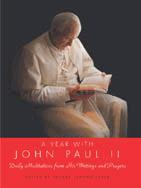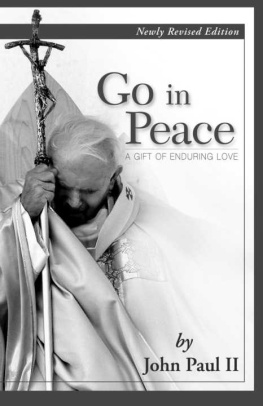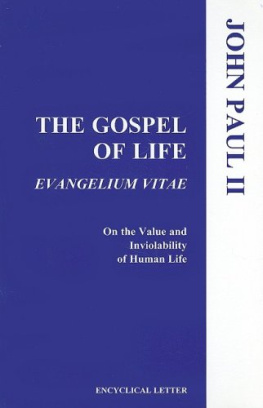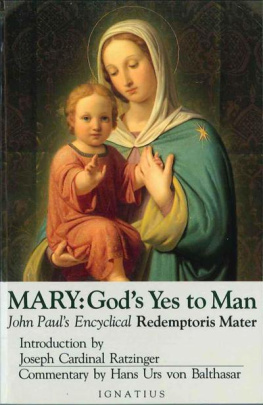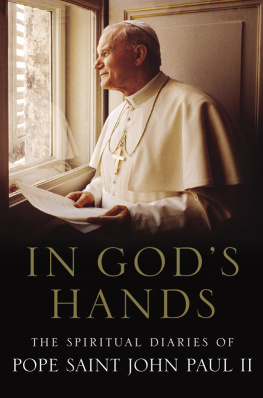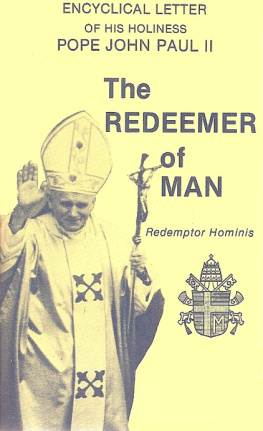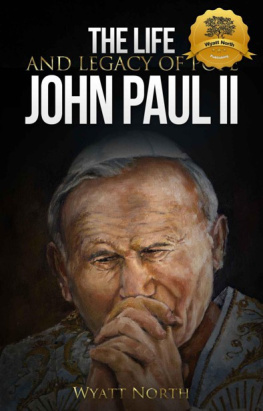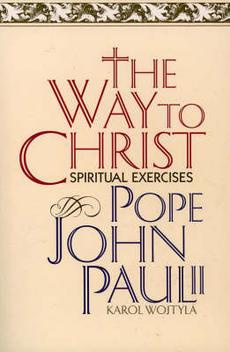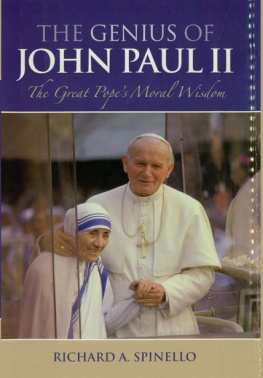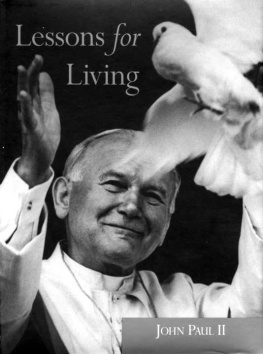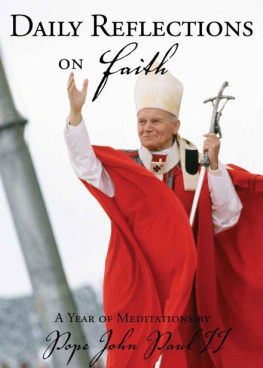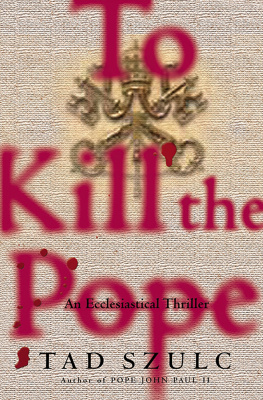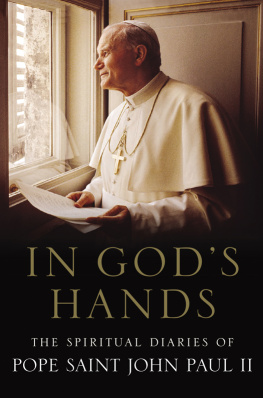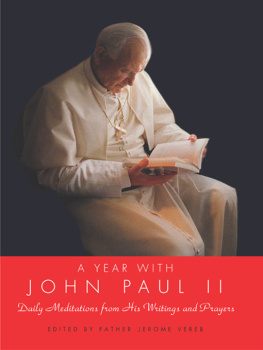A Year with
John Paul II
Daily Meditations from
His Writings and Prayers
Pope John Paul II
Edited by Jerome M. Vereb, C.P.

Dedicated to Rev. Msgr. Francis J. Schneider, J.C.D., Rector,
and to all the faculty, staff, and students, past and present,
on the Seventy-fifth Anniversary of the
Seminary of the Immaculate Conception,
Huntington, Long Island, New York
Contents
Foreword
Preface
Introduction
January
February
March
April
May
June
July
August
September
October
November
December
Epilogue
Latin Language Documents Index
Permissions and credits
About the Editors
Credits
Cover
Copyright
About the Publisher
By His Eminence William Cardinal Baum
Pope John Paul II is perhaps best remembered by the nations of the world for his affirmation of the dignity of the human person. This affirmation was rooted in his conviction that Jesus Christ is the answer to every human question. In the ministry of the Word, the mystery of man comes alive. In Jesus Christ, the Word Incarnate, the Living God himself discloses to each one of us the fullness of our own humanity. Throughout the ministry of Pope John Paul II, in his encyclicals, his catecheses, and his discourses, and especially in his speeches before the United Nations, this was his constant exhortation to the world: that every human person has great dignity and value. This universal dimension of the unique revelation in Christ was the message he bore to all, Christians and non-Christians alike.
karol Wojtylas vision of the dignity of every person was grounded in his personal experience and carefully developed by his formidable intellectual and spiritual powers. One of his primary insights into human dignity came through his experience of human suffering.
His mother died when he was a child, his only brother several years later. He was barely nineteen when Nazi Germany invaded Poland. When his father died a few years after that, he was on his own in hostile circumstances. During these years and the decades of Communist oppression that followed, he saw many people suffer simply because of their moral integrity and adherence to the faith.
It was during the Second Vatican Council (196265) that the Church at large became aware of Cardinal Wojtylas insights into the dignity of every man and woman, particularly because of his major contribution to the Pastoral Constitution Gaudium et Spes. He laid out the intellectual and philosophical roots in his foundational book The Acting Person.
Pope John Paul II quickly showed that this would be a theme of his pontificate in his early encyclicals. Redemptor Hominis, Dives in Misericordia, and Dominum et Vivificantem are devoted to the Persons of the Blessed Trinity in relationship to one another and to the life of the world. This thorough reflection on the one Gods self-revelation as three divine Persons made it possible for him to address the question of the nature of man, who is made in the image of that Triune God. These relationships reveal the awesome dignity of each human life.
In Dominum et Vivificantem, he pronounced that the spirit of the Father and of the Son is given to the Church for the sake of the fulfillment of every human person. He developed the teaching of the Second Vatican Council that each and every person is called to holiness and everlasting life.
In his personal vision of holiness he was strongly influenced by St. Louis de Montfort. He came to see himself, with Mary, as being bound up in the mystery of Christ and of the pilgrim Church. He wanted this awareness to be available to everyone. In his rich Marian devotion, he entrusted his life and his papacy to the protection of the Blessed Mother.
His personal prayer nourished his understanding of human dignity. One had only to observe him at prayer to be aware that he was taking with him into the presence of God the personal lives and sufferings of all those entrusted to his pastoral care.
My own experiences and memories provide a cherished familiarity with the Servant of God John Paul II. He was motivated in his every action by the fundamental truths of Christian belief, that is: the triune nature of God; the incarnation of the divine Word; redemption in and by Jesus Christ; and the role of the Blessed Virgin Mary in the economy of salvation. With every minute of his life, he unfailingly proclaimed the truth of essential human dignity, and in so doing, changed the world. He was the greatest man of his time.
May he rest in eternal peace, and may his memory be everlasting. Praised be Jesus Christ, now and forever.
William Cardinal Baum, S.T.D.
Penitenziere Maggiore Emerito
Vatican City State
Feast of the Ascension, May 5, 2005
The task of assembling this material was begun before the death of Pope John Paul II on April 2, 2005. Often I would bring my thoughts about these selections from the late pontiffs writings to my meditation in the chapel of the seminary crypt as I would prepare for Mass. I wondered how I would order the selections and indeed which selections would I make. I was helped in this matter by the very presence of a mosaic of Jesus as the Christos Pantocrator (Christ the Ruler). In that image the vestiges of the Church rest at his feet: fanciful Gothic stonework is in ruins; a bishops miter and a bishops crosier lie amid both the rubble and the bones of those bishops who might have worn them. Now that Pope John Paul has passed away, this image serves as a stark reminder that even the Bishop of Rome, like the bishops of Brooklyn and Rockville Centre whose bodies rest here, bows in death before the majesty of the Son of God.
As I received the news of the death of the man formally known as Karol Wojtyla, I found myself asking what the legacy of both his teaching and action would be. Having served in several capacities in Rome during his pontificate, I am compelled to say that his was a unique legacy of humility and grace. He was a gifted teacher and a dramatic articulator of the gospel. I, therefore, have made these selections in an attempt to show his universal personality and the quiet yet urgent character of his personal depth. I am struck by three core elements of his ministry as Bishop of Rome. They are ecumenism, phenomenological philosophy, and his use of the word solidarity.
Ecumenism: I remember being present on the steps of St. Peters Basilica on the day Pope John Paul II inaugurated his pontificate. I was, at that time, a staff member of the Secretariat for Promoting Christian Unity. How surprised we all were, when more representatives of other religious traditions and families appeared than for deaths of either Pope John XXIII or Pope Paul VI, themselves both ecumenical pontiffs. Personally, the new pope expressed his wonder at what he should do before so many diverse expressions of the Christian faith. To the White Father Pierre Duprey, at that time Undersecretary of the Secretariat for Promoting Christian Unity, he said, You must help me because Ive had no previous experience of anything at all like this in Krakow.
The Orthodox, Anglican, and Protestant leaders sat near the new pope during the Mass of inauguration. At the end of the ceremonies, he came directly before them waving his crosier, which like that of Pope Paul VI was styled as a crucifix. He lifted the shepherds staff, emphasizing the body of the Savior, as if to say, In Christ, we are already all one.

